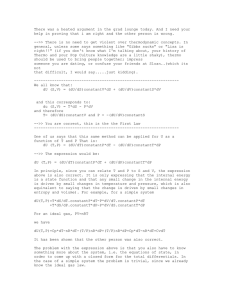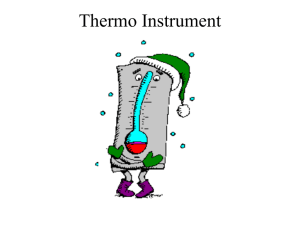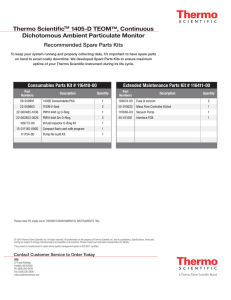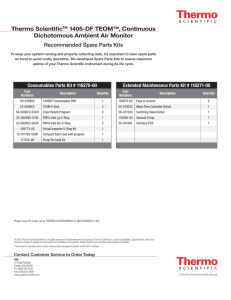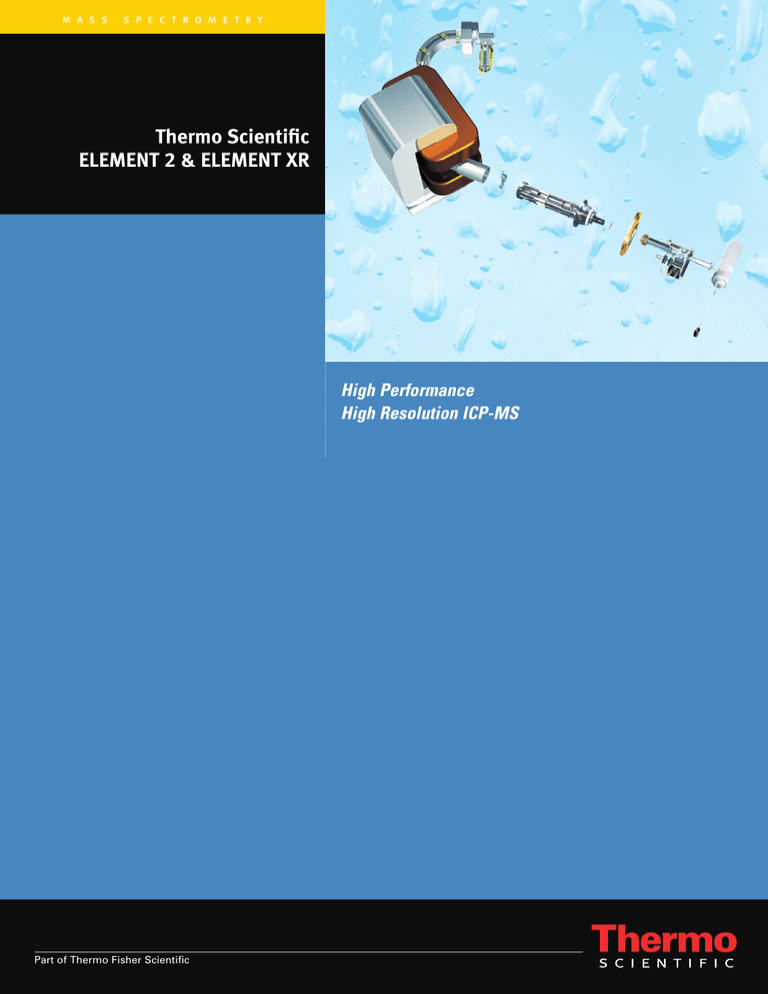
m a s s
s p e c t r o m e t r y
Thermo Scientific
ELEMENT 2 & ELEMENT XR
High Performance
High Resolution ICP-MS
Part of Thermo Fisher Scientific
Thermo Scientific ELEMENT 2/XR
High Performance High Resolution ICP-MS
Thermo Scientific ELEMENT 2/XR
High Performance High Resolution ICP-MS
An Instrument for every Application
A success story around the world with over 500 instruments
installed, for example:
Belgium: OCAS.
Research centre for the application of steel
with New Wave laser ablation system.
Sweden: ALS Scandinavia AB.
Scandinavia’s leading contract lab with
Emma Engström.
www.ocas.be
www.analytica.se
Canada: Seastar Chemicals Inc.
A manufacturer of high purity chemicals
with Dr. Brad McKelvey.
USA: Micron Technology Inc.
Advanced semiconductor solutions with
Kevin Coyle.
www.seastarchemicals.com
www.micron.com
Germany: Institute for Transuranium Elements.
USA: Desert Research Institute.
Shown with a glovebox for radioactive
sample measurements.
Hydrologic Sciences Division with
Steve Lambert.
http://itu.jrc.ec.europa.eu/
www.dri.edu
• Multielement analysis across the periodic table covering
a mg/L to sub pg/L concentration range
– Compatible with inorganic and organic solution
matrices and solids
• High mass resolution to access spectrally interfered isotopes
– Produces unambiguous elemental spectra
• A multielemental detector for transient signals
– For example, CE, HPLC, GC, FFF and laser ablation
• High precision isotope ratios
– Independent of interferences or interfered isotopes
• Fully automated tuning and analysis
– In conjunction with a comprehensive, customizable
quality control system
• Reliability and robustness to serve as a 24 / 7 production
control tool
– Highest sample throughput
• Highest flexibility and accessibility to
serve as an advanced research tool
Thermo Scientific ELEMENT 2/XR
High Performance High Resolution ICP-MS
High Mass Resolution
The unequivocal separation of analyte ions
from spectral interferences is a prerequisite
of accurate and precise analysis. High mass
resolution is the universal means for this
separation.
Spectral interferences are the main
limitation of ICP-MS. The argon plasma gas,
water, acid and the sample matrix itself can
combine to introduce a wide range of polyatomic ion species. The resultant interfering
species may have the same nominal mass
as an analyte ion and thus return a falsely
high value for the analyte. Numerous
strategies have been used in order to try to
minimize or circumvent the formation of
these spectral interferences. These include
mathematical corrections, special sample
introduction systems, special plasma
parameters and collision/dynamic reaction
cells to neutralize part of the interferences.
High resolution with a sector-field mass
spectrometer simply distinguishes the analyte
from interference by difference in mass.
The capability of high mass resolution is
a feature unique to the ELEMENT 2/XR
product lines. This ability can be used for
quantification and isotope ratio analysis for
nearly the whole periodic table, and in
almost all matrices.
14
N16OH
N16O
15
30.94
30.95
30.96
30.97
30.98
Mass [u]
30.99
31.00
31.01
30.99
31.00
31.01
Zoom in
31
30.94
30.95
30.96
30.97
P
30.98
Mass [u]
Phosphorus in UPW, Medium Resolution
28
Si
Even in a sample matrix as simple as
ultra pure water (UPW), interferences
do exist especially at low analyte
concentration levels:
C O
12 16
N2
14
27.94
27.95
27.96
27.97
27.98
Mass [u]
27.99
28.00
28.01
Silicon in UPW, Medium Resolution
C O2
12 16
28
Si16O
Ca
44
43.90
43.92
43.94
Calcium in UPW, Medium Resolution
43.96
Mass [u]
43.98
44.00
The more complex the sample matrix, the
wider the range of interferences that will
occur. The main advantage of high mass
resolution as a technique to remove spectral
interferences is that it is not just limited to a
particular type of interference. With high
mass resolution, iron at m/z 56 is easily
separated in a simple matrix from 40Ar16O as
well as in more complex matrices from, for
example, 40Ca16O or 12C216O2.
Arsenic at m/z 75 can be determined in
HCl, separated from the 40Ar 35Cl interference,
or, in a matrix containing Ca and chloride,
from 40Ca35Cl.
Matrices such as mineral acids and
organic solvents, which form a plethora of
spectral interferences, can be easily
analyzed using the high resolution mode.
S O2
32 16
S S
32 32
63.89
63.90
63.91
63.92
63.93
Mass [u]
63.94
63.95
63.96
63.97
63.94
63.95
63.96
63.97
Zoom in
Zn
64
63.89
63.90
63.91
63.92
63.93
Mass [u]
Zinc in H2SO4 (10 % w/w), High Resolution
High resolution results in simple clear
spectra and does not create new
interferences.
Ar16O
40
C216O2
12
Fe
56
55.80
55.85
55.90
55.95
Mass [u]
56.00
56.05
56.10
Iron in Liquid Crystal Matrix, Cold Plasma, Medium Resolution
Ca16OH
44
Ca16O
44
Ni
60
Ca16O
46
Ca16OH
32S16O12C
43
59.88
59.90
59.92
59.94
59.96
59.98 60.88 60.90
Ni
62
Ni
61
60.92
60.94
60.96
60.98 61.88
Mass [u]
Nickel Isotopes in Groundwater, Medium Resolution
61.92
61.92
61.94
61.96
61.98
Resolution Specification
(10 % peak valley definition)
3 fixed resolutions:
Low Resolution > 300
Medium Resolution > 4000
High Resolution > 10000
Thermo Scientific ELEMENT 2/XR
High Performance High Resolution ICP-MS
Principle
The ELEMENT 2 is a double
focusing magnetic sector field
ICP-MS.
Plasma and Interface
The argon plasma ion source and sampling
interface of the ELEMENT 2/XR are at
ground potential1. This enables the
straightforward coupling of peripherals like
HPLC, CE, GC and laser ablation. The
interface reduces the initial kinetic energy
spread from ~20 to ~5 eV by capacitively
decoupling the plasma from the load coil,
using a grounded guard electrode. This
reduced energy spread increases the ion
transmission and delivers superior
sensitivities at all resolutions.
The ion transfer optics focus the ions
from the plasma interface on the entrance
slit of the double focusing analyzer. The ion
transfer optics are designed for low
background, highest sensitivity and
minimum mass bias at maximum stability 2.
High Resolution
• Highly laminated, water cooled
magnet, m/z: 7 - 240 - 7 in < 150 ms
• 25 ppm/8 hour mass stability
The ELEMENT 2/XR is able to fully
automatically change between three fixed
resolutions by switching the positions of the
entrance and exit slits in < 1 s. The patented
design of the fixed slit mechanism3 offers
maximum stability and reproducibility of
resolutions.
MR
Patent issued: US 5552599, GB 2282479
2 Patent issued: US 5625185
3 Patent issued: US 5451780, GB 2281438
1
LR
HR
• 3 fixed resolutions:
R = 300
R = 4000
R = 10000
• Ion Transfer Optics
Guarantees a flat response curve,
low background and high sensitivity
Mass Separation
• Simultaneous measurement in analog
and counting modes
• > 109 linear dynamic range (ELEMENT 2)
• > 1012 linear dynamic range (ELEMENT XR)
• < 0.2 cps dark noise
• Fully automatic cross calibration
The magnetic field disperses ions according
to their mass and energy. The magnet used
in the ELEMENT 2/XR is specifically
designed for use in ICP-MS applications. It is
relatively small (sufficient for the mass range
0 – 260 u), highly laminated and efficiently
water-cooled for the highest mass stability.
Changing of the magnetic field is controlled
by a magnetic field regulator with a new
high power stage, which delivers the fastest
scan speed ever possible with a magnetic
sector field instrument 4.
After passing through the magnetic field
the ions enter the electrostatic analyzer for
energy focusing. The combination of the
magnetic and electrostatic fields results in the
double focusing, high resolution properties of
the ELEMENT 2/XR.
Detection System
• Interface at ground potential
• Easily changeable cones
• Resistant against chemicals
The ELEMENT 2 is equipped with a discrete
dynode detector system. Rather than having
the ion beam directly strike the detector to
initiate an electron cascade, the secondary
electron multiplier implemented in the
ELEMENT 2 uses a conversion dynode at -8
kV, producing a uniform response across the
mass range. The detector is linear over nine
orders of magnitude – from ppq to ppm
concentrations. The quantification of trace
and major elements is therefore possible in
a single analysis.
Another step ahead
The detection system of the ELEMENT XR
increases the linear dynamic range to > 1012
orders of magnitude by incorporating a
single Faraday detector.
• Torch with Guard Electrode (GE)
The GE decreases the ion energy spread, thus increasing
ion transmission. This and the high acceleration voltage
used in a sector field ICP-MS results in increased
sensitivity. The GE is also required for Cold Plasma
measurements
4
Thermo Scientific Technical Note
TN30074_E
Low Resolution
350000
300000
Intensity [cps]
Low resolution (R = 300) is used for the
analysis of non-interfered isotopes. In this
mode the ELEMENT 2‘s sensitivity is the
highest of all commercially available ICPMS instruments. Additionally, the flat top
peak shape is an advantage for high
precision isotope ratio measurements.
Medium Resolution
Medium resolution (R = 4000) guarantees
interference-free analysis for most elements
in the majority of sample matrices. For
example, transition elements are routinely
measured in medium resolution due to the
formation of many interfering polyatomic
species in the mass range 24 – 70 u.
250000
200000
150000
100000
50000
0
114.6
114.7
114.8
114.9
Mass [u]
115.0
115.1
115.2
100 ng/L 115In, Low Resolution
High Resolution
35000
30000
Intensity [cps]
High resolution (R = 10000) is used for the
analysis of elements in the most
challenging sample matrices. For example,
high resolution is used to separate As and
Se from argon dimer interferences and
argon chloride interferences in chlorine
matrices, heavy rare earth elements from
light rare earth element oxides in geological
matrices, platinum group elements from
argon-transition metal molecular species,
and/or the oxides of Hf, Ta and W.
25000
20000
15000
10000
0
114.88
114.89
114.90
Mass [u]
114.91
114.92
100 ng/L 115In, Medium Resolution
6000
5000
Intensity [cps]
Thermo Scientific ELEMENT 2/XR
High Performance High Resolution ICP-MS
Resolution
40000
30000
20000
10000
0
114.895
100 ng/L 115In, High Resolution
114.900
114.905
Mass [u]
114.910
Since the change in mass resolution is
achieved by changing the width of the
entrance and exit slits of the mass
spectrometer, the instrumental sensitivity
of a high resolution ICP-MS is dependent
on the resolution mode used. Therefore,
the ELEMENT 2/XR with three fixed
resolutions has three sensitivities: the wider
the slit, the higher the sensitivity.
7000
Intensity [cps]
6000
5000
179
4000
Hf16O
3000
2000
Fixed sensitivity ratio between resolutions:
independent of mass and matrix.
Pt
195
1000
0
194.90
194.85
194.95
Mass [u]
195.00
195.05
195.10
Even in high resolution mode, the intrinsic
sensitivity of the ELEMENT 2/XR provides
sub ppt detection limits.
100 µg/L Hafnium, 100 ng/L Platinum, High Resolution
60000
40
Intensity [cps]
50000
Ar12C
40000
30000
20000
10000
52
Cr
Cl16O
37
Cr
53
0
52.0
52.2
52.4
Mass [u]
52.6
52.8
53.0
Chromium in Blood, Medium Resolution
250000
Eu16O
153
Intensity [cps]
200000
150000
100000
50000
169
Tm
0
168.86
168.88
168.90
168.92
168.94
Mass [u]
Thulium in Europium Matrix, High Resolution
168.96
168.98
169.00
Sensitivity Specification
Low Resolution (R = 300)
115In > 1x106 cps/ppb
Medium Resolution (R = 4000)
115In > 1x105 cps/ppb
High Resolution (R = 10000)
115In > 1.5x104 cps/ppb
Background in all 3 resolutions < 0.2 cps
Sensitivity and Low Background
It is obvious that the highest instrumental
sensitivity is essential to achieve the lowest
detection limits. However, it is the signal to
noise ratio that dictates the detection limit.
The ELEMENT 2/XR guarantees an off-peak
background of < 0.2 cps for all three
resolutions. Detection limits in the fg/L
range are possible.
0.8
Intensity [cps]
0.7
226
Ra
0.6
0.5
0.4
Detection Limits in Complex
Matrices
0.3
Even in cases where the lowest detection
limits are not the goal, the exceptionally
high sensitivity of the ELEMENT 2/XR offers
an important advantage. With the higher
sensitivity, higher dilution factors for
complex matrices can be used without
sacrificing detection limits.
0.1
0.2
bkg<0.2 cps
bkg<0.2 cps
0.0
225.4
225.6
225.8
226.0
226.2
226.4
Mass [u]
Mineral Water, undiluted (5 % HNO3), ~200 fg/L Radium, Low Resolution
Sensitivity and ‘Dilute and Shoot’
The requirement for matrix separation for
samples such as seawater, mineral acids or
organic solvents is replaced by a simple
dilution. Using this ‘dilute and shoot’
approach, the matrix load on the sample
introduction system, plasma and interface is
reduced. This is also particularly important
for the analysis of nuclear sample matrices
where the minimization of waste is of
paramount importance.
LoD [ng/L]
in solution
Resolution
23 Na
Low
Low
Low
Low
Medium
Medium
Medium
Medium
Medium
High
High
90 Zr
107Ag
151Eu
47 Ti
52 Cr
63 Cu
66 Zn
79 Br
75 As
155 Gd
1.3
0.06
0.03
0.04
0.3
0.3
0.6
1.5
5.0
2.0
0.2
Detection Limits in 50 mg/L Uranium
6
Normalized Intensity [ppq]
Thermo Scientific ELEMENT 2/XR
High Performance High Resolution ICP-MS
Sensitivity and Stability
5
4
3
2
1
0
0
1
2
3
4
Concentration [ppq]
Ra, External Calibration, 1, 4, 6 pg/L, R2 = 1.000
226
5
6
Signal Stability and Detection
Limits
Sector field ICP-MS offers superior ion
transmission stability due to the high
acceleration voltage (-8 kV) and excellent
focusing properties.
In combination with the high sensitivity,
low background, interference-free
measurements and an advanced sample
introduction system, the ELEMENT 2/XR
delivers the lowest detection limits –
independent of the sample matrix. The
resulting low detection limits combined with
highest stability at single digit ppt level enable
quantification at the lowest concentrations.
120
Intensity [cps]
100
80
60
40
20
0
5.1 ng/L As
-5
0
5
Concentration [ppt]
10
15
Standard Addition Analysis of Arsenic in HCl (10 % v/v)
110
100
Recovery [%]
90
80
70
60
50
Cu
Zr
Ag
Ba
Tl
Cr
element
Mn
Li
Na
Fe
1 ng/L Spike Recovery UPW
concentration [ppt]
6.0
5.8
Sn120(LR)
2.5%
5.6
Fe56(MR)
2.2%
5.4
As75(HR)
4.1%
Signal Stability 2 Hours Low,
Medium and High Resolution: 5 ng/L
5.2
5.0
Stability Specifications
< 1 % RSD in 10 minutes
< 2 % RSD in 1 hour
4.8
4.6
4.4
4.2
4.0
1
2
3
4
5
6
7
8
9
analysis #
10
11
12
13
14
15
16
The mature design of the
ELEMENT 2 delivers the fastest
scan speed ever for a magnetic
sector field ICP-MS. With the
ELEMENT 2 a jump from 7 to 240
to 7 is realized in < 150 ms.
Mass (m/z)
Coil Current (A)
10
5ms
5ms
9
238
8
m/z 238- 7
m/z 238- 7
50ms
50 ms
7
6
5
Scanning
4
Routine scanning is performed by a
combination of magnetic and electric jumps.
The ELEMENT 2/XR has the unique
capability to scan +30 % from the magnet
mass by decreasing the acceleration
voltage. The magnetic field is kept constant
while the acceleration voltage is varied.
This ingenious combination of scan
techniques delivers the fastest scanning
ever realized by a sector field ICP-MS.
3
2
m/z 7-238
m/z 7-238
75ms
75ms
7
5ms
1
5ms
5ms
0
0
50
100
150
200
Time (ms)
Timing for a Full Magnet Cycle
Mass Stability
The ELEMENT 2/XR guarantees the highest
mass stability of any ICP-MS. This enables
fast peak top jumping analyses rather than
scanning across the whole peak, thus
significantly decreasing analysis times. A
combination of mature hardware and
intelligent software guarantees mass
stability in high resolution, which makes
mass calibration a rare event.
The synthesis of these characteristics
combined with high sensitivity, allowing short
integration times, makes the ELEMENT 2/XR
the fastest sector field ICP-MS ever.
77.921
77.92
77.919
77.918
Centroid Mass
Thermo Scientific ELEMENT 2/XR
High Performance High Resolution ICP-MS
Mass Stability
77.917
77.916
77.915
77.914
77.913
The scan speed of the ELEMENT 2 in
combination with the high sensitivity
opens the dimension of its use as a
detector for fast transient signals.
Analysis
y-scale is equivalent to peak width in high resolutiom
12-Hour Mass Stability for 78Se in high resolution
Specifications
Mass stability: 25 ppm / 8 hours
Magnetic scan speed: m/z 7 to 240 to 7 < 150 ms
250
Ion Detection System
analog
signal
Electrons
Conversion
Dynode
e-
The goal of real life analysis is
the simultaneous determination
of major and trace elements.
12345
counting
signal
analog
m+
Ions
ELEMENT 2 Ion Detection System
counting
SEM
The ELEMENT 2 is equipped with a discrete
dynode detection system that enables the
quantification of both trace and major
elements in a single analysis across a
dynamic range of 109.
The ELEMENT 2 detector system
incorporates a conversion dynode at -8 kV.
The high acceleration to -8 kV results in a
mass independent detector response,
enabling fully automatic cross calibration
between the counting and analog modes.
No user interaction is necessary.
The automatic cross calibration ensures a
constantly updated detector response at all
times – ready for the unexpected sample!
Additionally the detector enables the
measurement of large isotope ratios. With
the minor isotope in counting mode and the
abundant isotope in analog mode the highest
precision and accuracy can be obtained.
Another step ahead
ELEMENT XR Ion Detection System
The most recent high resolution ICP-MS, the
Thermo Scientific ELEMENT XR, opens
another dimension of linearity in ICP-MS.
Incorporating a single Faraday detector in
addition to the discrete dynode detector offers
> 12 orders of magnitude linear dynamic
range. Herewith the dream of analyzing
ultra-trace elements and matrix elements
within the same analysis becomes true!
Extremely short integration times of < 1
ms in analog and Faraday mode, and 0.1 ms
in counting mode in combination with a
switching time of 1 ms between analog and
faraday mode, makes the ELEMENT XR the
perfect tool for transient signals such as
those from laser ablation.
Specifications
Dynamic Range > 109 with automatic
gain calibration (ELEMENT 2)
Dynamic Range > 1012 with automatic
gain calibration (ELEMENT XR)
Thermo Scientific ELEMENT 2/XR
High Performance High Resolution ICP-MS
The Software Suite
The ELEMENT 2/XR Software
Creating and Running Sequences
The ELEMENT 2/XR software controls and
monitors all instrument functions for ICPMS analysis. This includes data acquisition
and auto-tuning of the ELEMENT 2/XR.
The software also provides the full
range of quantification procedures required
in elemental analysis (qualitative,
quantitative, semi-quantitative, isotope
dilution) as well as isotope ratio and time
resolved analysis modes.
• Intuitive and easy creation of sample
analysis sequences in graphical or
spreadsheet display modes
• Integrated powerful QA/QC package that
meets internationally regulated
requirements including US EPA 200.8 and
6020. The flexible editor included can be
used to define specific QA/QC criteria in
any laboratory.
Controlling and Tuning
•Remote Control & Diagnostic
• Autotuning of all parameters, including
ICP parameters, torch position, lenses and
multiplier voltage
• Fully automated and configurable plasma
start and stop sequence
• Easy autosampler setup using a graphical
display of the autosampler
Displaying Results and Creation
of Reports
• Real time display of spectra, calibration
curves, fully quantitative results and time
resolved analyses
• On-line export of time resolved data in
several formats (ASCII, GRAMS,
Spectacle, GLITTER, ANDI and Xcalibur®
for further analysis in third party programs
•Setting & Read-Back of All Instrument Parameters
Setup of Methods
• Intuitive and easy selection of target
isotopes in periodic table or spreadsheet
display modes
• Automatic, customizable isobaric
interference correction
• Spreadsheet style ‘click-and-drag’ cell
fill down
Displaying Results and Creation
Instrument Startup and Autosampler Control
The ELEMENT 2/XR software is a state-of-the-art, simple to use software suite taking advantage of the
reliability and stability of Windows™ XP Professional. The software package is optimized for the needs of
the routine analyst, providing stability and ease of use for basic operation of the ELEMENT 2/XR, and yet
retains the flexibility for advanced operation.
Due to the use of the Windows™ XP Professional operating system and standardized programming, the
data system computer can be easily connected to a network, enabling data transfer and allowing remote
control of the ELEMENT 2/XR.
Product Specification
Specifications and Installation Requirements
Sensitivity (Concentric Nebulizer)
Detection Power
Dark Noise
Dynamic Range
Mass Resolution
Signal Stability
Scan Speed (magnetic)
Scan Speed (electric)
Oxide and Doubly Charged Ions
Power
Environment
Cooling Water
Argon
Plasma Exhaust
Electronics Exhaust
> 1 x 109 counts per second (cps)/ppm In
< 1 ppq for non-interfered nuclides
< 0.2 cps
> 109 linear with automatic gain calibration (ELEMENT 2)
> 1012 linear with automatic gain calibration (ELEMENT XR)
300, 4000, 10,000 (10 % valley, equivalent to 5 % height);
600, 8000, 20,000 (FWHM)
< 1 % RSD over 10 minutes
< 2 % RSD over 1 hour
m/z 7 to 240 to 7 < 150 ms
1 ms/jump, independent of mass range
ratio
measured
BaO+/Ba+
< 0.002
Ba2+/ Ba+
< 0.03
3-phase, 230/400 V ±10 %,
50/60 Hz fused 32 A per phase
Power consumption: ~9 kVA
Temperature 18 – 24 °C (64 – 75 °F)
Humidity 50 – 60 %, noncondensing,
non-corrosive
~ 200 l/h
Temperature 10 – 20 °C
4 – 6 bar (43 – 65 psi)
Purity 99.996 min.
18 L/min
Regulated pressure 8 –10 bar (116 –145 psi)
Uninterrupted argon supply recommended
1 x 6 cm Ø; 90 m3/h
(Argon + suspended sample)
2 x 15 cm Ø; 800 m3/h
ELEMENT 2 and ELEMENT XR:, Footprint and Dimensions
(all dimensions in cm)
125
103
67
36
63
141
37
79
174
106
88
141
33
Plasma Capabilities from Thermo Fisher Scientific
The use of an Inductively Coupled Plasma
source (ICP) is the accepted and most
powerful technique for the analysis and
quantification of trace elements in both solid
and liquid samples. Its applications range
from routine environmental analyses to the
materials industry, geological applications to
clinical research and from the food industry
to the semiconductor industry.
Thermo Fisher Scientific is the only
instrument manufacturer to offer the full
range of Inductively Coupled Plasma
Spectrometers (ICP, Quadrupole and Sector
Field ICP-MS) to satisfy every aspect of
plasma spectrometry from routine to highly
demanding research applications.
Develop your lab from the easy-to-use
Thermo Scientific iCAP ICP to the high
performance Thermo Scientific XSERIES 2
Quadrupole ICP-MS and up to the ultrasophisticated ELEMENT 2 and NEPTUNE
Sector Field ICP-MS instruments. Each
instrument combines leading-edge
technology, fit for purpose and affordability
with a tradition of quality, longevity,
accuracy and ease of use.
For direct analysis of conductive
materials down to the parts per billion
(ppb), Thermo Fisher Scientific also offers
Glow Discharge technology: the Thermo
Scientific ELEMENT GD.
In addition to these offices, Thermo
Fisher Scientific maintains a network
of representative organizations
throughout the world.
Africa
+43 1 333 5034 127 • analyze.emea@thermo.com
Australia
+61 2 8844 9500 • analyze.au@thermo.com
Austria
+43 1 333 50340 • analyze.at@thermo.com
Belgium
+32 2 482 30 30 • analyze.be@thermo.com
Canada
+1 800 530 8447 • analyze.ca@thermo.com
China
+86 10 8419 3588 • analyze.cn@thermo.com
Denmark
+45 70 23 62 60 • analyze.dk@thermo.com
Europe -Other
+43 1 333 5034 127 • analyze.emea@thermo.com
France
+33 1 60 92 48 00 • analyze.fr@thermo.com
Germany
+49 6103 408 1014 • analyze.de@thermo.com
India
+91 22 6742 9434 • analyze.in@thermo.com
Thermo Scientific
iCAP ICP
Thermo Scientific
XSERIES 2 ICP-MS
Italy
+39 02 950 591 • analyze.it@thermo.com
Japan
+81 45 453 9100 • analyze.jp@thermo.com
Latin America
+1 608 276 5659 • analyze.la@thermo.com
Middle East
+43 1 333 5034 127 • analyze.emea@thermo.com
Netherlands
+31 76 579 55 55 • analyze.nl@thermo.com
South Africa
+27 11 570 1840 • analyze.sa@thermo.com
Spain
+34 914 845 965 • analyze.es@thermo.com
Thermo Scientific
ELEMENT 2/XR Sector Field ICP-MS or
ELEMENT GD Glow Discharge ICP-MS
Thermo Scientific
NEPTUNE Multicollector ICP-MS
Sweden / Norway / Finland
+46 8 556 468 00 • analyze.se@thermo.com
Switzerland
+41 61 48784 00 • analyze.ch@thermo.com
UK
+44 1442 233555 • analyze.uk@thermo.com
USA
+1 800 532 4752 • analyze.us@thermo.com
www.thermo.com
©2016 Thermo Fisher Scientific Inc. All rights reserved.
Windows is a registered trademark of Microsoft
Corporation in the United States and possibly other
countries. All other trademarks are the property of
Thermo Fisher Scientific Inc. and its subsidiaries.
Specifications, terms and pricing are subject to change.
Not all products are available in all countries. Please
consult your local sales representative for details.
BR30027_E 08/16C

